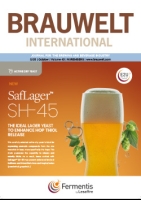Commercial fluxcalcined kieselguhr or coarse kieselguhr is produced using sodium carbonate as fluxing agent. This coarse kieselguhr contains crystalline structures of silicon dioxide, mainly cristobalite and opal-CT. These crystalline structures are, in respirable form, classified as carcinogenic material and thereby cause concern in occupational health and disposal of spent material. In this paper the influence of the formation of crystalline material during fluxcalcination of kieselguhr using various fluxing agents is described. Additionally characteristics of the kieselguhr samples, concerning the suitability as filter aid have been investigated. Samples were heat treated from 900 °C to 1050 °C for 1h to 4h in a muffle kiln..
Response surface methodology was used to investigate the influence of three malting parameters, degree of steeping, germination time and temperature, on the quality of triticale malt. Each predictor variable was tested at three levels. Germination times were set to 5, 6, and 7 d, degrees of steeping to 42, 45, and 48 %, and germination temperatures were 15, 18 and 21 °C. The initial kilning temperature for all malts was set to 50 °C and gradually increased to 80 °C. A series of malt quality attributes were investigated including extract, viscosity, arabinoxylan, apparent attenuation limit, α- and β-amylase activity, limit dextrinase activity, α-amino nitrogen (FAN), Kolbach index, soluble N and dimethyl sulfide precursor (DMS-P).8 % extract, 78.305 mPa × s viscosity..
The European Beer Star was set up in 2004 and has become a renowned competition by now where international independent experts award beers in their respective categories. In 2009 the event will take place for the sixth time, attracting brewers from all over the world. BRAUWELT International talked with Dr. Werner Gloßner of the Association “Private Brauereien Bayern [EV]” about the initial objectives of the European Beer Star, its history and success and its commitment to a traditional and authentic art of brewing.
Total nitrogen content of barley, malt and beer was usually measured by Kjeldahl method. In brewing science this method has been used for many years to measure total protein (N x 6.25 = protein concentration) in beer, but it measures nitrogen rather than proteins. Kjeldahl method determines total nitrogen but is prone to interference from non-protein and nitrogen-containing compounds, and fails to detect subtle changes in the protein content of wort and beer.
A prerequisite for the production of lightstable beers is the use of reduced hop products, iso-alpha acids which have been converted into rho-, tetra- and hexa-hydro-iso-alpha acids.
In France, Spain and for a large part also in UK, the sowing of spring barley ended at the end of March. In many other countries of Europe the work couldn’t be done because of the wet and cold weather. At the beginning of April with warm and dry weather, there is a good possibility to do the sowing. Larger effects because of the delay are not expected.
Increased demand for hops worldwide for many years has resulted in the breeding of hop plants and consequent development of new varieties with ever increasing alpha acid concentrations. This trend was accompanied by the introduction of 2 new classifications, one called “High-Alpha varieties”, the other called “Super-High-Alpha varieties”.
Hops is one of the most interesting research fields world-wide and hitherto we are not even close to discover the whole range of possible applications for hops. In 2007 the Barth-Haas Group started to award each year grants to support hop research projects. These grants are meant for the Diploma thesis, master thesis or seminar papers of students who are working on a project concerning hops and its application in brewing. Theses that have been finished meanwhile, about flavour stability, sensory evaluation methods, hop harvest in belarus etc. impressingly demonstrate the wide range of hop research.
With different styles, scents and flavours, the Brazilian beer market is an excellent business. In volume, the country is currently only behind China, United States, Germany, and Russia. According to the last survey by Sindicato Nacional da Indústria da Cerveja (Sindicerv – National Beer Industry Syndicate), the Brazilian market has produced 10.34 billion litres of beer in 2007. Consumption per capita was of 56 litres. The sector has earned R$ 25.8 billion and invested R$ 3 billion in the last five years.
For brewers, the most important compounds of hops are the alpha acids. During wort boiling the insoluble alpha-acids isomerise to soluble iso-alpha acids which are the main bittering compounds in beer. Depending on hop variety and hop product, there are several soluble unspecific resins other than the iso-alpha acids which contribute to beer bitterness. The content of “non alpha bitterness” can be shown by comparing the unspecific EBC 7.5 method with the specific HPLC method used for the determination of alpha acids (EBC 7.7). The ratios of these two methods are demonstrated in figure 1 and 2 for fresh aroma and bitter hops: ...
The International Subcommittee for Isomerized Hop a-Acids Standards (ISIHAS), announces the release of a new calibration standard, ICS-I3, for the HPLC analysis of iso-¦Á-acids. This standard replaces ICS-I2, which is now withdrawn.
BrewingScience - Monatsschrift für Brauwissenschaft, 62 ( January/February) 2009, p. 25


